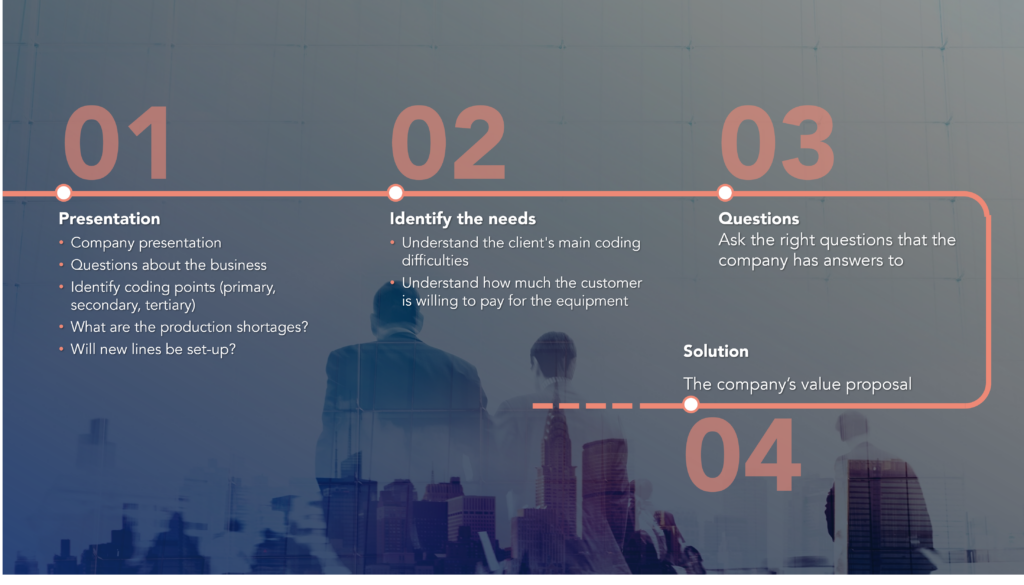The company
A machinery business company focused on selling equipment, consumables, and maintenance services for equipment with more than 60 specialized employees and more than 1500 clients from all industrial sectors.
The challenge
As a company with moderate growth in recent years, a focus on client needs, and the desire to always do better, the organization decided to review its strategy to sustain double-digit annual growth.
New initiatives and goals emerged from the strategic review, among them the improvement of the commercial, technical, and purchasing departments. In the diagnosis performed on these departments, it became clear that the lack of planning and standardization of work and the lack of control over the teams’ indicators had a negative impact on sales growth.
The improvement project involved four significant areas of the company: Marketing, Commercial, Aftermarket, and Service.
The approach
Marketing
To penetrate the client base, its segmentation was carried out, and industry-oriented content was developed in accordance with pain points and the value proposition.
This maximized the effectiveness of the marketing messages. Case studies and white papers were also produced, aiming at producing relevant insights for potential clients.
A Marketing plan was developed to guide the actions and help achieve the goals proposed for the company’s growth.
A telemarketing area was also set up to attract new high-potential clients actively.
Commercial
The improvement of the sales team was based on a set of initiatives that aimed to increase the sales volume and quality of the sales teams.
Classification of clients by type was carried out, which enabled the definition of a strategy adapted to each type of client and distribution of clients by type of salesperson (large accounts vs. normal accounts).
Sales standards were defined to improve the sales process from preparation to evaluation. The sales script was improved, and standards for sales meetings were created. We also identified the main objections and the company’s points of differentiation from the competition.

The structure and process of proposal development have also been improved. Errors and gaps in information, which were frequent in the past, were eliminated by creating online forms to survey requirements in the field.
Also, in this scope, a computer app was developed to support commercials to create proposals more quickly. The reduction of the production time of samples for the client also contributed to reducing the proposal presentation Lead Time.
Another of the topics worked on was the planning of visits which allowed a better allocation of resources to the needs, increasing the efficiency and productivity of the team. A client visit map and a bi-weekly analysis routine were created for the commercial team’s planning.
The implementation of Daily KAIZEN™ allowed for strategy alignment, frequent monitoring of key indicators, and immediate countermeasures whenever necessary. The creation of a purchase funnel and the weekly tracking of commercial activity in SalesForce (calls, meetings, samples, demonstrations) also contributed to the team’s improvement.
Skills matrices were developed, and training plans for the sales team on the product and service portfolio were defined.
All these dynamics have created a culture of continuous improvement within the teams.
To encourage sales, monthly and sector-specific promotional campaigns were developed, the concept of up-selling was introduced in the proposals (client training, installation, spare parts), and the value of commercial commissions for rental products was increased.
A commercial assistant was also introduced to assist commercials in managing information and communication with other internal departments: Purchasing, Service, and Finance.
Still, within the project’s scope, a process was created to manage and monitor the physical demonstrations at target clients.
Aftermarket
The team responsible for the aftermarket was also the target of improvement.
The team was restructured so that it could be organized by value stream. A value stream organization is a process focused on the value stream, i.e., the set of actions that occur to provide value to a client – from the initial order to its delivery. This restructuring allowed us to optimize value delivery to the client and reduce inefficiencies.
Weekly and monthly meetings were implemented to analyze deviations and review the improvement cycle, keeping the team aligned and focused on the objectives.
We worked on developing analytical tools to control indicators and prioritize clients to contact, automatic reporting tools, freeing up the team for higher value-added tasks, tools for signaling clients to contact (based on periodic purchases or missing complementary products), and business profitability control tools. To make contacts more efficient and effective, call scripts were created.
The planning of the production process was also improved, resulting in increased efficiency and the management of raw material purchases.
Results
Implementing all these improvements resulted in a 12% increase in sales. The project also impacted other indicators, as the Lead Time from lead acquisition to the presentation of the commercial proposal was reduced from 12 to 8 weeks, and the win rate increased from 40% to 53%.
The improvements were implemented with the company’s teams, developing their knowledge and experience and creating a culture of continuous improvement.
#marketing and sales #assembly manufacturing
See more on Assembly Manufacturing
Find out more about transformation in this sector
See more on Marketing & Sales
Find out more about improving this business area
